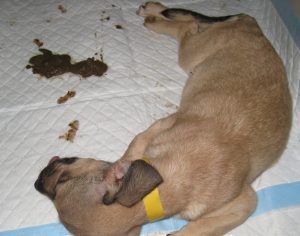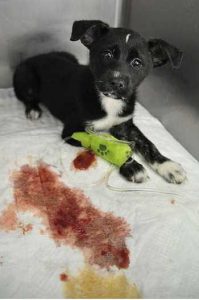Module 4: Healthcare practices for common contagious infectious diseases
Canine Parvovirus Treatment

Treatment of canine parvoviral enteritis largely is supportive until clinical signs of vomiting and diarrhea resolve. The standard of care treatment in a hospital ICU setting includes intravenous fluid therapy to replace fluid losses, electrolyte and glucose supplementation, anti-emetics for vomiting, broad spectrum antibiotics to control secondary bacterial infections and sepsis, early nutrition via a nasogastric tube, and alleviating abdominal pain to improve welfare. Treatment with topical anthelmintics for intestinal parasites is associated with better survival. The standard of care treatment costs can exceed $1000 to $3000, including the costs of intensive care and monitoring via blood tests.
In-shelter treatment of canine parvovirus should only be pursued if the shelter has sufficient resources, including good isolation housing to prevent spread of disease, daily veterinarian oversight, trained medical care staff for delivery of care and monitoring responses, and a budget to support care without compromising other healthcare practices for the population as a whole. Most shelters do not have the staffing, supplies, and budgets to provide the standard of care treatments used in a hospital ICU.
Prior to Dr. Wright’s arrival, the Gatorland Animal Services policy for CPV-infected dogs was euthanasia. Dr. Wright investigated an alternative CPV treatment protocol used by many shelters that saves 80% of infected dogs at a fraction of the cost associated with in-hospital care. This alternative treatment is a modification of the Colorado State University Outpatient Protocol designed for outpatient treatment of infected dogs whose owners cannot afford in-hospital care.
A study at the Pennsylvania SPCA shelter community clinic summarized outcomes for 95 dogs treated with a modified outpatient CPV treatment protocol.
- 83% survival rate
- Twice daily assessments and medication administration.
- Average number of days required for SQ fluid treatment was 4.
- Increasing number of days with clinical signs prior to treatment and an increase in body weight during treatment were significantly associated with survival.
- Dogs with low body weight, hypothermia, not eating, and 8% or greater dehydration were less likely to survive.
- The estimated cost of treatment per dog using this outpatient protocol was $479.
A report from the Austin Pets Alive shelter summarized the results of in-shelter treatment of more than 5000 CPV-infected dogs using alternative protocols similar to the CSU Outpatient Protocol.
- 87% survival rate
- Median treatment time of 7 days per dog.
- Volunteers administered twice daily treatments and the average time invested in each dog was 9 hours over the 7-day treatment period.
- Treatment success was associated with selection of dogs that weighed at least 5 lb – lower body weight was associated with higher risk for mortality.
- Treatment cost averaged between $56 and $300 per dog.
- These results show that CPV can be successfully treated in a sustainable low-cost manner in a shelter setting using a largely volunteer workforce.
The success of the modified outpatient treatment protocol in the shelter is dependent upon careful selection of patients based on weight, degree of dehydration, and severity of other clinical parameters. Based on clinical study outcomes, factors associated with high mortality include low body temperature (<100F), low body weight (<5 lb), and >8% dehydration. Surprisingly, leukopenia is not associated with higher mortality risk.

Excited about the possibility of saving some dogs, Dr. Wright created a CPV Treatment Selection Flowchart for selection of dogs most likely to respond to her new CPV Treatment Protocol adapted from the outpatient protocol. She also created a CPV Treatment Checklist and CPV Treatment Flowchart to help the vet techs implement the protocol.

